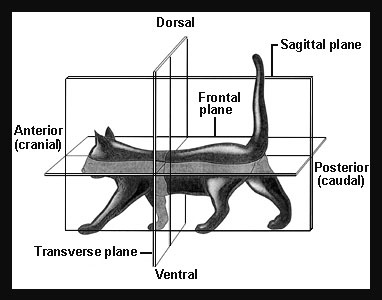|
|
||||||||||||||||||||
|
Just as the terms north, south, east and west are used to indicate directions on the surface of the earth, anatomical terms have been developed to mark the position of various organs and body parts. For example, in a typical quadruped such as a cat, the anterior (front) end moves forward and the posterior or caudal (tail) end follows. The dorsal (top) side is kept facing upward and the ventral (bottom) side is kept down and usually specialized for locomotion. The three planes that divide a quadruped animal are as follows: the sagittal plane divides the body into right and left sides; a transverse plane divides the body into anterior and posterior portions; and a frontal plane divides the animal into dorsal and ventral halves. Other useful anatomical terms include medial (toward the center of the body), lateral (toward the side of the body), proximal (nearer to the reference point) and distal (further from the reference point). Thus, the outside of the leg is the lateral surface while the inside is the medial surface, and the distal end of the humerus (the arm bone) articulates with the radius and ulna of the forearm, while the proximal end fits into a socket in the scapula. |
|
